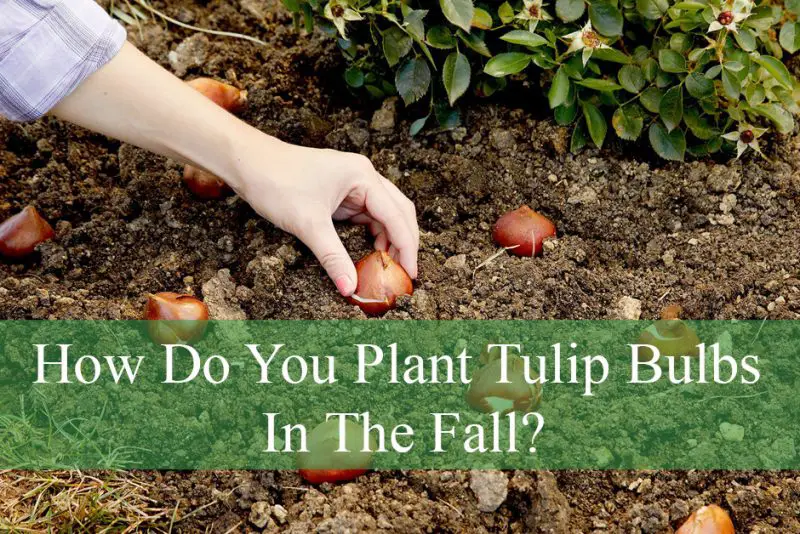Planting tulip bulbs in the fall is a rewarding gardening activity that ensures a spectacular burst of color in spring. Tulips are among the most popular spring-flowering bulbs, loved for their vibrant colors, elegant shapes, and variety of types. However, successful tulip gardening starts months earlier—right in the fall, when the bulbs are planted. Understanding how to plant tulip bulbs properly during this season is crucial to achieving beautiful blooms and healthy plants year after year.
This guide will walk you through the essential steps, tips, and considerations for planting tulip bulbs in the fall, from selecting bulbs to preparing the soil, planting techniques, and aftercare. Whether you are a beginner gardener or an experienced flower enthusiast, mastering fall tulip planting will bring joy and color to your garden come spring.
Why Plant Tulip Bulbs in the Fall?

Planting tulip bulbs in the fall is necessary because tulips require a cold period to trigger blooming. This chilling period, which occurs naturally during winter, breaks the bulb’s dormancy and initiates the biological processes needed for growth and flowering.
The fall planting allows the bulbs enough time to establish strong root systems before winter sets in. Roots begin to grow while the bulbs remain dormant above ground, giving the tulip a head start once spring arrives. Without adequate chilling, tulips may fail to bloom or produce weak flowers.
Another reason fall planting is important is that it aligns with the natural growth cycle of tulips, which are native to regions with cold winters and dry summers. Mimicking these conditions as much as possible increases the chance of success in your garden.
When Is the Best Time to Plant Tulip Bulbs in the Fall?
Timing is critical when planting tulip bulbs. The ideal planting window usually falls between late September and early November, but this varies depending on your geographic location and local climate.
Temperature Considerations
Tulip bulbs should be planted when soil temperatures drop to about 50 to 60 degrees Fahrenheit (10 to 15 degrees Celsius). This temperature range allows the bulbs to settle into the soil and develop roots without sprouting prematurely. Planting too early in warm soil can cause the bulbs to rot, while planting too late may not give roots enough time to establish before the ground freezes.
Regional Differences
In colder climates, it is best to plant tulip bulbs as soon as the soil is cool enough, often in late September or early October. In milder regions where winters are less severe, you may have until November to plant. However, if planting is delayed past this window, bulbs might struggle with root development or sprout too early, leading to poor flowering.
Gardening centers often recommend planting tulip bulbs about 6 to 8 weeks before the first hard frost. This rule of thumb helps ensure the bulbs receive enough cold exposure to bloom properly the following spring.
Choosing Quality Tulip Bulbs for Fall Planting
The quality of tulip bulbs you select in the fall greatly influences your gardening success. Healthy bulbs are plump, firm, and free from mold, cuts, or bruises. Avoid bulbs that feel soft, shriveled, or have visible signs of disease.
Types of Tulip Bulbs
Tulip varieties vary widely in size, color, bloom time, and hardiness. Darwin hybrids and species tulips are excellent choices for perennializing and naturalizing, while single early or late tulips add diversity and vibrant color ranges to your garden.
Some bulbs are pre-treated or coated to protect against pests and diseases, which can improve survival rates. Always buy bulbs from reputable suppliers and select varieties suited to your USDA hardiness zone for the best results.
Preparing Your Garden Bed for Tulip Bulbs
Proper soil preparation before planting is key to healthy tulips. Tulips prefer well-drained soil with a neutral to slightly acidic pH (between 6.0 and 7.0). Heavy clay or waterlogged soils can cause bulbs to rot or develop fungal diseases.
Improving Soil Drainage and Fertility
If your soil is compacted or poorly draining, consider amending it with organic matter such as compost or well-rotted manure. This improves aeration and nutrient content, supporting root growth. In sandy soils, adding organic matter helps retain moisture and nutrients.
Avoid using fresh manure or high-nitrogen fertilizers right before planting as these can burn the bulbs. Instead, incorporate balanced, slow-release fertilizers or bone meal that support bulb development.
Clearing and Loosening the Soil
Before planting, clear the garden bed of weeds, rocks, and debris that could impede root growth. Loosen the soil to a depth of about 12 inches (30 cm) using a garden fork or tiller. This loosening allows the roots to penetrate easily and access nutrients and water efficiently.
How Deep and How Far Apart Should You Plant Tulip Bulbs?
Correct planting depth and spacing influence the bulbs’ ability to establish roots, grow strong stems, and produce flowers.
Ideal Planting Depth
The general rule of thumb is to plant tulip bulbs at a depth three times the height of the bulb itself. For most tulip bulbs, this means planting about 6 to 8 inches (15 to 20 cm) deep. Planting too shallow can expose bulbs to freezing or drying out, while planting too deep may delay or reduce blooming.
Spacing Between Bulbs
Spacing bulbs properly allows each tulip enough room to grow without competition. A common spacing recommendation is to plant bulbs 4 to 6 inches (10 to 15 cm) apart. Closer spacing can create a denser, more naturalized look, but overly tight clusters might reduce airflow and increase disease risk.
For tulips planted in containers, use the same depth and allow room for root growth by leaving at least 2 to 3 inches (5 to 8 cm) between bulbs.
Step-by-Step Guide to Planting Tulip Bulbs in the Fall
Planting tulip bulbs follows a straightforward process when done carefully and with attention to detail. Here is how you can ensure your bulbs are positioned correctly for successful growth.
Start by digging individual holes or a trench to the recommended depth using a trowel or garden spade. Place each bulb with its pointed tip facing upwards and the flat, root end downwards. This orientation helps the sprout emerge easily and roots grow downward.
Cover the bulbs gently with soil and press down lightly to eliminate air pockets that could dry out roots. Water the newly planted area thoroughly to settle the soil around the bulbs and initiate root growth.
If planting in an area prone to rodents such as squirrels or voles, consider placing a layer of hardware cloth or wire mesh at the bottom of the holes or trench to protect bulbs from being dug up.
Caring for Tulip Bulbs After Planting
After planting, ongoing care through fall and winter is minimal but important to ensure healthy bulbs and strong blooms.
Watering
Tulip bulbs do not require heavy watering after planting unless the fall season is exceptionally dry. The initial watering helps settle the soil, but from then on, natural rainfall usually suffices. Overwatering or poor drainage, however, can cause bulbs to rot.
Mulching
Applying a layer of mulch, such as shredded leaves, straw, or bark chips, helps moderate soil temperature, conserve moisture, and prevent weeds. Mulch also protects the bulbs from extreme temperature swings and freezes during winter.
In colder regions, a thicker mulch layer may be necessary to insulate bulbs from severe frost.
What to Expect When Tulips Start Growing in Spring
As winter fades, tulip bulbs awaken from dormancy, and their roots and shoots begin to grow. Foliage pushes through the soil first, followed by buds that eventually open into flowers.
During this time, tulips require consistent moisture and full to partial sunlight to thrive. Avoid heavy fertilization once shoots appear, as this can promote excessive leaf growth at the expense of blooms.
By following proper fall planting and care techniques, your tulips will reward you with vibrant, healthy flowers that brighten your spring garden.
Troubleshooting Common Problems in Fall Tulip Planting
Even with good preparation, gardeners may encounter issues such as bulb rot, poor blooming, or pest damage.
Preventing Bulb Rot
Bulb rot is often caused by excessive moisture or planting in poorly drained soil. Ensuring well-draining soil and avoiding overwatering reduces the risk. If planting in heavy clay soil, raise beds or amend the soil for better drainage.
Dealing with Pests
Rodents like squirrels, voles, and mice sometimes dig up tulip bulbs for food. To deter them, use physical barriers such as wire mesh or plant bulbs in containers.
Encouraging Strong Blooms
Weak or few blooms often result from planting bulbs too shallow, insufficient chilling, or cutting foliage prematurely. Always plant at correct depths and allow leaves to die back naturally after flowering to nourish bulbs.
Frequently Asked Questions About Planting Tulip Bulbs in the Fall
When is the best time to plant tulip bulbs in the fall?
The best time to plant tulip bulbs is typically 6 to 8 weeks before the first hard frost in your area. This usually means planting between late September and early November, depending on your local climate. The soil temperature should be around 50 to 60 degrees Fahrenheit to allow root development without premature sprouting.
How deep should I plant tulip bulbs?
Tulip bulbs should be planted about three times as deep as the bulb’s height, which is usually around 6 to 8 inches (15 to 20 cm) deep. Planting at this depth helps protect the bulb from temperature fluctuations and encourages strong root growth.
Can I plant tulip bulbs in pots instead of the ground?
Yes, tulip bulbs can be planted in pots or containers. Use a well-draining potting mix, plant bulbs at the same depth recommended for garden beds, and ensure the container has drainage holes. Container-grown tulips should be kept in a cool place during winter to simulate natural chilling.
How do I protect tulip bulbs from pests?
Rodents such as squirrels and voles can dig up tulip bulbs. To protect them, use hardware cloth or wire mesh at the bottom of planting holes or cover the planting area with chicken wire. Planting bulbs in pots or raised beds can also reduce the risk of pest damage.
Should I water tulip bulbs after planting in the fall?
After planting, water the bulbs thoroughly to settle the soil. Beyond that, tulips usually do not need additional watering during fall unless there is an extended dry period. Overwatering can lead to bulb rot, so it’s important to ensure the soil drains well.
Can tulips naturalize and come back every year?
Some tulip varieties, especially Darwin hybrids and species tulips, are better at naturalizing and can return year after year. However, many garden tulips behave more like annuals in warmer climates or poor soil conditions, and gardeners often replant them each fall for consistent blooms.
What should I do with tulip foliage after blooming?
After tulips finish blooming in spring, allow the foliage to die back naturally before cutting it off. The leaves provide essential nutrients back to the bulb, supporting next year’s growth. Cutting leaves too early can weaken the bulb and reduce future flowering.
Can I plant tulip bulbs too late in the fall?
Planting tulip bulbs too late can prevent roots from establishing before the ground freezes, resulting in poor blooms or bulbs that fail to grow. If you miss the ideal planting window, consider chilling the bulbs indoors before planting or wait until next fall for best results.
Conclusion
Planting tulip bulbs in the fall is the foundation of a successful spring garden bursting with color and life. By choosing quality bulbs, planting at the right time and depth, preparing the soil properly, and providing minimal but thoughtful care, gardeners can enjoy the timeless beauty of tulips each year.
Understanding the needs of tulips during the fall planting season sets the stage for healthy growth, vibrant blooms, and a rewarding gardening experience. With patience and attention to detail, anyone can master the art of fall tulip planting and look forward to stunning flowers as winter gives way to spring.






